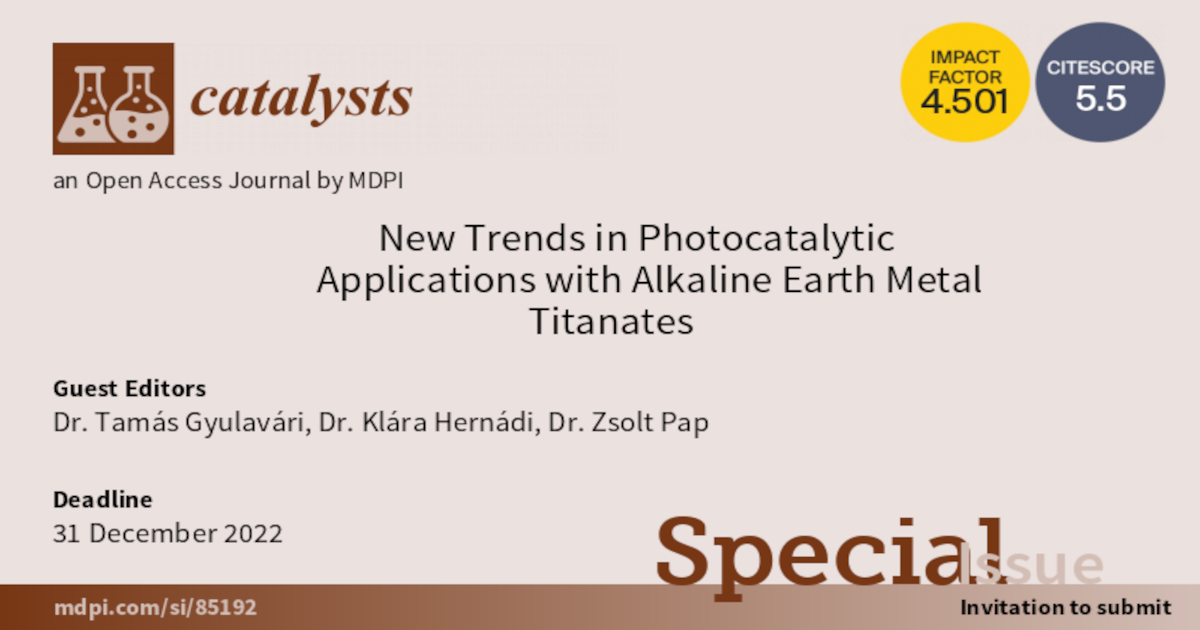New Trends in Photocatalytic Applications with Alkaline Earth Metal Titanates
A special issue of Catalysts (ISSN 2073-4344). This special issue belongs to the section "Photocatalysis".
Deadline for manuscript submissions: closed (7 July 2023) | Viewed by 23530

Special Issue Editors
Interests: heterogeneous photocatalysis; semiconductor oxides; titanium dioxide; characterization; photocatalytic activity; catalyst preparation; nanomaterials; material science; environmental applications
2. Department of Applied and Environmental Chemistry, University of Szeged, Szeged, Hungary
Interests: heterogeneous catalysis; photocatalytic materials; carbon nanotubes; nanocomposite materials; immobilization of biologically active units
Special Issues, Collections and Topics in MDPI journals
2. Faculty of Biology and Geology, Babeș-Bolyai University, Centre 3B, STAR-UBB, Cluj-Napoca, Romania
Interests: photocatalysis; ecotoxicology; environment–nanoparticle interaction; photochemistry
Special Issues, Collections and Topics in MDPI journals
Special Issue Information
Dear Colleagues,
Heterogeneous photocatalysis is a promising method to treat a wide variety of environmental pollutants. It is an extensively investigated research area; moreover, semiconductor oxides already have industrial applications. Alkaline earth metal titanates, a novel group of semiconductors, have attractive application prospects due to their unique properties, making them suitable for pollutant degradation, CO2 reduction, H2 generation, energy storage, and fuel cells, just to name a few. However, there are still many unanswered questions regarding the causal relationship between their structural and photocatalytic properties.
This Special Issue aims to collect papers concerning the design, synthesis, and characterization of alkaline earth metal titanates, as well as focus on their applicability. I am pleased to invite you to submit manuscripts for this Special Issue on “New Trends in Photocatalytic Applications with Alkaline Earth Metal Titanates” in Catalysts.
Dr. Tamás Gyulavári
Dr. Klára Hernádi
Dr. Zsolt Pap
Guest Editors
Manuscript Submission Information
Manuscripts should be submitted online at www.mdpi.com by registering and logging in to this website. Once you are registered, click here to go to the submission form. Manuscripts can be submitted until the deadline. All submissions that pass pre-check are peer-reviewed. Accepted papers will be published continuously in the journal (as soon as accepted) and will be listed together on the special issue website. Research articles, review articles as well as short communications are invited. For planned papers, a title and short abstract (about 100 words) can be sent to the Editorial Office for announcement on this website.
Submitted manuscripts should not have been published previously, nor be under consideration for publication elsewhere (except conference proceedings papers). All manuscripts are thoroughly refereed through a single-blind peer-review process. A guide for authors and other relevant information for submission of manuscripts is available on the Instructions for Authors page. Catalysts is an international peer-reviewed open access monthly journal published by MDPI.
Please visit the Instructions for Authors page before submitting a manuscript. The Article Processing Charge (APC) for publication in this open access journal is 2200 CHF (Swiss Francs). Submitted papers should be well formatted and use good English. Authors may use MDPI's English editing service prior to publication or during author revisions.
Keywords
- Heterogeneous photocatalysis
- Perovskites
- Alkaline earth metals
- Titanates
- Environmental applications
- Pollutant degradation
- Photoreduction
- Carbon dioxide
- Energy storage
- Fuel cells
Benefits of Publishing in a Special Issue
- Ease of navigation: Grouping papers by topic helps scholars navigate broad scope journals more efficiently.
- Greater discoverability: Special Issues support the reach and impact of scientific research. Articles in Special Issues are more discoverable and cited more frequently.
- Expansion of research network: Special Issues facilitate connections among authors, fostering scientific collaborations.
- External promotion: Articles in Special Issues are often promoted through the journal's social media, increasing their visibility.
- Reprint: MDPI Books provides the opportunity to republish successful Special Issues in book format, both online and in print.
Further information on MDPI's Special Issue policies can be found here.







